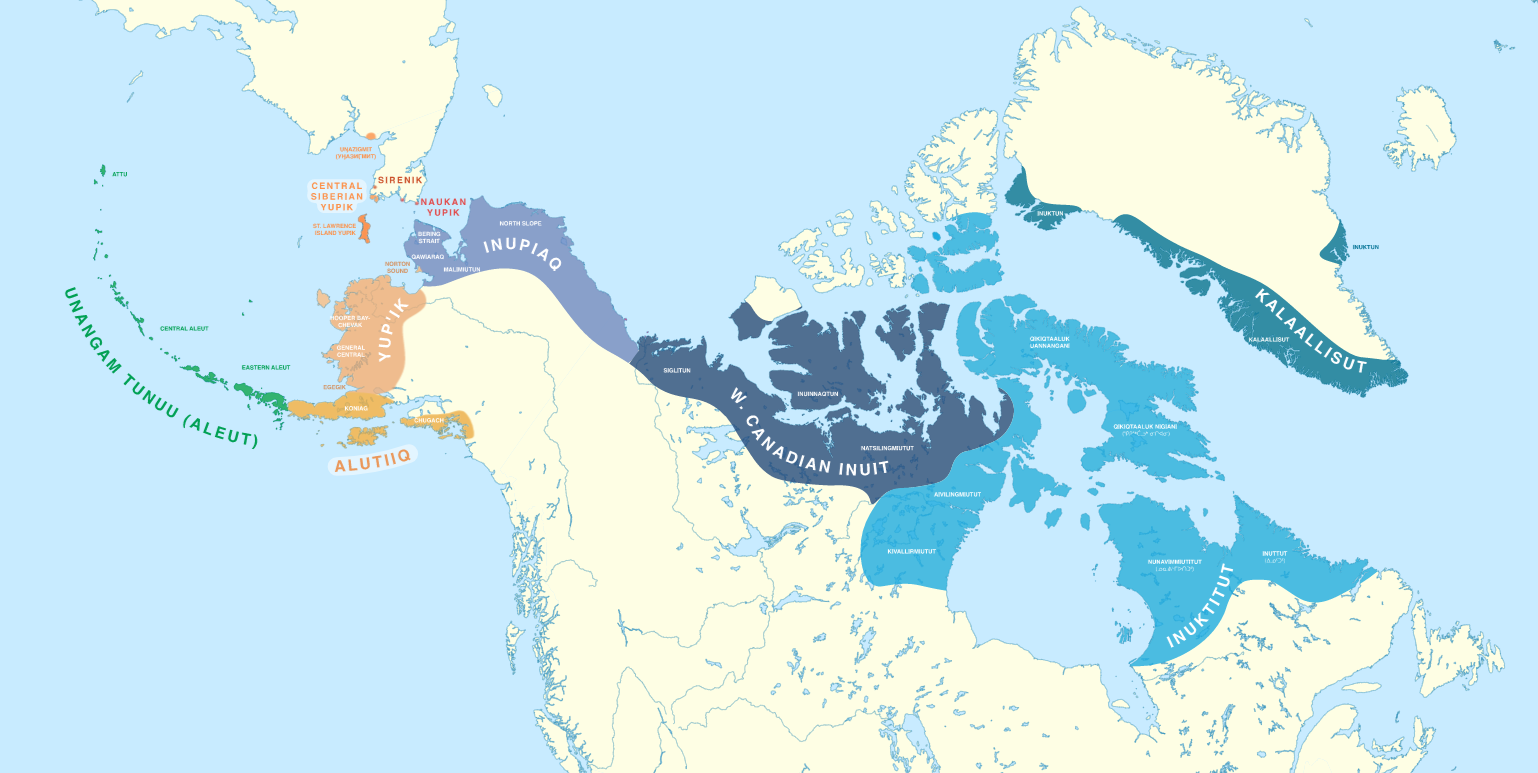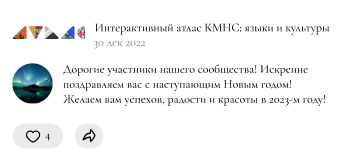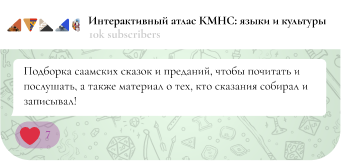Naukan Language
I. Sociolinguistic Data
I.1. Alternative Names
Naukan is the language of the Naukan Yupik/Eskimo. The language name is derived from the name of the settlement of Naukan (Нувуқақ in Naukan), where speakers of the Naukan Eskimo language historically lived. In English this language is referred to as the Naukan Yupik language or the Naukan Siberian Yupik language.
I. 2. General Characteristics
I. 2.1. The Number of Native Speakers and the Corresponding Ethnic Group
Census data estimates the number of Naukans (as well as the number of Naukan speakers) are approximate since traditionally, censuses tended to mesh all the groups of Asian Eskimos (consequently, speakers of three languages: Chaplinski (or Chaplino dialect, Chaplinski Yupik), Naukan and now extinct Sirenik) into one ethnic group. The 2010 census records 1738 people as Eskimos. According to academic estimates, around 350 of them are Naukans. All in all, 688 people named an Eskimo language as their first language, 508 people recorded mastery of their first language (with no specification how well they can speak it). This number includes speakers of both Chaplinski and Naukan, but the majority of them speak Chaplinski, while according to the scholarly estimates, not more than 50 people can speak Naukan currently.
I
.2.2. Age of Speakers
Only elderly people can speak Naukan proficiently, while representatives of the middle-aged generation do not speak the language fluently. Young people and children do not know Naukan at all.
I
.2.3. Sociolinguistic Characteristics
I.2.3.1. Threat of Extinction
Naukan is close to extinction. The language is no longer passed down from older generations to the younger ones, for parents and grandparents do not speak to their children in their first language. All Naukan speakers can speak other languages, for example, traditionally, nearly all men and many women know Chukot well and all Naukans can speak Russian.
I.2.3.2.
Use in Various Fields
|
Area
|
Use
|
|
Family and everyday communication
|
limited
|
|
Education: kindergartens
|
no
|
|
Education: school
|
no
|
|
Higher education
|
no
|
|
Education: language courses/clubs
|
no
|
|
Media: press (including online publications)
|
no
|
|
Media: radio
|
no (there used to be)
|
|
Media: television
|
no
|
|
Culture (including existing folklore)
|
no
|
|
Literature in language
|
no
|
|
Religion (use in religious practices)
|
no
|
|
Legislation + Administrative activities + Courts
|
no
|
|
Agriculture (including hunting, foraging, deer herding, etc)
|
no
|
|
Internet (communication/ sites in the language, non-media)
|
no
|
As this table shows, Naukan has only limited use in family and everyday communication.
I.2.4. Writing System
Naukan has no official writing system. It is due to the fact that the two Eskimo languages within the Russian Federation, Naukan and Chaplinski, were traditionally considered to be one Eskimo language, so the issue of coming up with two Eskimo alphabets has never been addressed, since these two languages traditionally use the same alphabet. The Eskimo alphabet was based on the Cyrillic alphabet. There are several variants of the alphabet (and several corresponding spelling principles). The practical writing in Naukan (the alphabet and spelling systems used in literary publications in Naukan) is not different from the practical writing in Chaplinski. Scholarly publications on Naukan use a different system of the alphabet developed by G.A.Menovshchikov. This alphabet was used in his Naukan Eskimos’ Language. This alphabet is still used in publications produced by researchers, but it would be a mistake to suggest that these publications are only meant for an academic milieu, since they are just as interesting and valuable for speakers of Naukan and everyone interested in the language. These are the publications on Naukan folklore and Naukan vocabulary materials in G.A. Menovshchikov’s Naukan Eskimos’ Language (1975) and publications of folklore texts with linguistic, ethnographic and folkloristic commentaries in G.A.Menovshchikov’s Materials and Studies of the Language and Folklore of Naukan Eskimos (1987). The same alphabet (with some minor modifications specified in the Preface) is used in the Naukan Yupik Eskimo Dictionary, compiled by E.A. Dobrieva, E.V. Golovko, S. Jacobson and M. Krauss under the editorship of S. Jacobson in Alaska Native Language Center (2004).
I.3. Geographic Characteristics
3.1. Subjects of the Russian Federation with Compact Population of Native Speakers
Speakers of Naukan live in towns of Chukotka District of Chukotka Autonomous Okrug.
3.2. Total Number of Traditional Native Settlements
It is impossible to tell for sure where Naukan speakers used to reside. Originally, speakers of Naukan lived in the settlement of Naukan (Нувуқақ in Naukan) and villages around along Cape Dezhnyov: Nunak, Imtuk 2, Uelen (or Ulyk otherwise) and a number of other settlements to the north and south of the Bering Strait, later taken over by the Chukchi. The settlement of Naukan was abandoned in 1958 following the policies of settlement agglomeration. After Naukan was abandoned, its residents were moved to four different settlements: Uelen, Lavrentia, Pinakul (also shut down in the 1960s), and Nunyamo (shut down in 1976). Currently, most Naukans live in Lavrentia, Lorino and Uelen. The displacement led to the fragmentation of the Naukan community, and Naukans found themselves in minority compared with the prevailing Chukchi and Russians. It could only lead to ever diminishing number of speakers.
I.3.3.
List of Settlements
Up to 1958, the people lived in the settlement of Naukan (the territory of the current Chukotka District of the Chukotka Autonomous Okrug) and nearby villages. Currently, Naukan mostly reside in the settlements of Lavrentia, Lorino, Yelen of the Chukotka District of the Chukotka Autonomous Okrug.
Historical Dynamic
The data about the number of Naukan speakers dates back to the late 19th century. In 1895, N. Gondatti estimated that 300 Naukans resided in the area. In 1956, the census of Naukan population indicated that as of July 1956, there were 229 people, 201 of them were ethnically Eskimos, 6 Chukchi, and 22 Russians.
It is notable that, according to the census data, Eskimo population absolutely prevailed in Naukan. In the preface of the Naukan Yupik Eskimo Dictionary, Michael Krauss estimates the number of Naukans (speakers of Naukan who lived not only in Naukan, but thereabouts too) before the town was shut down to be 350 people. According to his data, currently, there are approximately 450 Naukans, around 250 of whom live in Lavrentia (with the total population of around 1400 people), around 90 in Uelen (with the population of around 700 people) and around 75 in Lorino (with the total population of around 1400 people). In the mid-20th century, the number of Naukan speakers probably roughly coincided with the number of Naukan residents (i.e., there were around 350 speakers). In the 1990s, N.B.Vakhtin in his Syntax of Asian Eskimos’ Language gave an estimate of approximately 50 Naukan speakers, Michael Krauss in 2004 arrived at around the same number (60 speakers), we find the same figure (50 speakers) in the webpage about the Naukan language on the Minority Languages of Russia Web Project (the data on the webpage are based on the results of an expedition the Institute of Linguistics of Russian Academy of Sciences sent to the Naukan Yupik people in 2002). So, it turns out that the number of speakers has not significantly changed for over 25 years since 1995. This phenomenon can be found repeatedly in languages with a small number of speakers: at one time the number of speakers made only a few dozen people (or just a few people), with speakers being quite elderly. Later, after generational change, it turned out that the number of speakers did not diminish. N.B. Vakhtin gives the following explanation of the phenomenon: “The older generation often serve as the representatives of traditional culture and the custodians of the ethnic language. Middle-aged speakers might even say that they “have forgotten their own language”, but in several years they reach a certain age and start representing the tradition. At this moment, it gets revealed they have quite a sustainable mastery of their ethnic language.”
There are no earlier data on Naukans: in the national censuses of the Russian Empire, the USSR and the Russian Federation, speakers of all Eskimo languages are recorded as Eskimos. One can only make a guess from general considerations that the number of Naukans throughout the 20th century grew steadily (in conjunction with the continuous growth of the Eskimo ethnic group: in the first 1897 general census of the Russian Empire 1099 people are recorded as Eskimos, in the 1926 census – 1292, in the 1959 census 1100 people, in 1970 – 1308 people, in 1989 – 1719 people, 2002 – 1750 people, in 2012 – 1738 people)
II. Linguistic Data
II
.1. Position in the Genealogy of World Languages
The Naukan language belongs to Eskimo-Aleut languages. This language group includes two branches: Aleut and Eskimo. The languages making up the Eskimo branch are divided into three groups: the now extinct Sirenik languages (the speakers of which adopted Chaplinski) makes up a separate group, the other two branches are Yupik languages (or the Yupik group), and Inuit languages (the Inuit group). All these three groups converge in Beringia, at the junction of two continents, Eurasia and North America, with only Yupik languages being present on both sides of the Bering Strait. The two branches – Yupik and Inuit – can be provisionally linked to two geographical points. The Inuit languages are distributed to the north of the city of Unalakleet on the shore of Norton Bay of the Bering Sea along the northern coast of Alaska, throughout the north of Canada right up to Greenland.
Since Russian and English titles of these languages differ considerably, we include both:
-
Alaskan-Inuit (Inupiaq)
-
West Canadian Inuit
-
East Canadian Inuit (Inuktitut in the map below)
-
Greenlandic Inuit (Kalaallisut, the official title of dialect is used on the map below)
Yupik languages are linked to the northern coast of the Bering Sea on both continents (consequently, in North America they are distributed to the south of Unalakleet).
Table 1. The Distribution of Eskimo Aleut Languages

The Yupik group consists of four languages. Since Russian and English titles for these languages differ substantially, both are included below:
-
Chaplinski (Central Siberian Yupik)
-
Naukan (Naukan Yupik)
-
Central Yupik (Central Alaskan Yupik)
-
Alutiiq or Pacific Gulf Yupik.
M.A. Chlenov and I.I. Krupnik argue that “American linguist Michael Krauss was the first to suggest there had been in the past a chain (a ring) of Yupik languages along the northern coasts of the Bering Sea. In the preface of the Naukan Yupik Eskimo Dictionary, Krauss writes that in the chain of Eskimo languages Naukan Yupik holds a special place in the very centre. It serves as the connection between the Central Alaskan Yupik spoken by Eskimos living in the territory from the Bristol Channel to Norton Bay and the Chaplinski Eskimo language (or Central Siberian Yupik). The latter language is spoken by residents of the village Novo-Chaplino, Sireniki and Uelkal in Chukotka as well as the Eskimos of St. Lawrence Island (the United States). While the residents of St. Lawrence and Alaska who speak Central Alaskan Yupik have difficulty understanding each other, Naukans can understand both equally and considerably well. So, one can say Naukan belongs to both Chukotka and Alaska.
Besides the genotype of the language (which reflects its history from the point of view of its separation from related languages), it is of great interest to picture inter-linguistic contacts in Beringia, which allow researchers to reconstruct an earlier, non-recorded status of the Naukan language. In fact, for a long time, Beringia was a zone of contact, rather than separation, of the two continents: Cape Dezhnyov, the Islands of Big and Little Diomede, the Seward Peninsula from the Alaskan side served as a bridge between the two continents. In the 20th century, the Eskimos of Eurasia and North America were finally divided by the gradually less permeable state frontiers: before that, there had been no unsurmountable geographical boundaries between the Asian and American parts of Beringia for Eskimos. According to M. Krauss, before the 1930s, Naukans had maintained relations not with their neighbours on land, the Chaplinski Eskimos, but with their neighbours across the sea, the Alaskan Eskimos, speaking Inupiaq of the Inuit group.
Now we will look into a possibility of reconstructing an even older distribution of speakers of Naukan. Michael Krauss draws our attention to the enigma of the names of two islands: the name of the Island of Little Diomede (Krusenstern Island) is literally translated from Naukan as “closer, more visible” while the Island of Big Diomede (Ratmanov Island) is literally translated as “invisible, the most distant, furthermost in the sea”. But if one looks at these islands from the Asian side, from Naukan, it is the island of Big Diomede (the one called the invisible) is closer and well-visible to the village, while Little Diomede (called the better visible) cannot be seen behind it. It all falls into place if one changes the perspective and looks at these islands from the American continent. Michael Krauss considers it to be proof (not the only one, but perhaps the most attractive one) that earlier Naukan was spoken along the whole of the coastline of the Bering Strait both in Chukotka and in Alaska.
Scholars do not divide Naukan into dialects and subdialects.
II
.2. History of Studying the Language
The first Naukan glossary was compiled in 1791 by Mikhail Robek during I. Billings’ expedition (along with Gavriil Sarychev he led the 1785-1794 expedition to explore and draw a map of the coastline of North-Eastern Siberia; it was G.Sarychev who published Billings’ Naukan Glossary in 1811). In 1895, N.L. Gondatti collected materials on Eskimo languages. In 1946, two texts in Naukan were recorded by E.S.Rubtsova, an outstanding researcher of Chukotka’s Eskimo languages. The systematic approach to studying Naukan was first introduced by G.A. Menovshchikov (his first expedition took six months in 1948, further expeditions took place in 1954-55, 1960-66 and in 1970). He described his observations in The Language of Naukan Eskimos (1975) and Materials and Research on the Language and Folklore of Naukan Eskimos (1987). The vocabulary of Naukan was later analysed and expanded by N.M. Emelyanova during her work on the card-index for the comparative dictionary of Eskimo languages in the 1960s-1970s. In the 1990s, the materials collected by N.M. Emelyanova were corrected and expanded by E.V. Golovko, who organised a number of expeditions to Chukotka. All this research was done under the Leningrad (later St. Petersburg) school of Eskimology. The year of 2004 witnessed the publication of The Naukan Yupik Eskimo Dictionary, compiled by E. A. Dobrieva, E.V. Golovko, S. Jacobson and M. Krauss. The dictionary structures and corrects the lexis of nearly all the available sources, both published and archived. It includes a wide range of archive materials (mostly texts) collected by a number of researchers: G.A. Menovshchikov’s notebook records, the notes by S.J acobson, M. Chlenov, E.V. Golovko and others. This line of genuinely ‘academic’ study of Naukan is complemented by studying and preserving the language by researcher and language research activists. For instance, one essential source for the Naukan Yupik Eskimo Dictionary was a handwritten Naukan dictionary by I.A. Leonova-Teplilyk (1935-1988), and includes around 2200 dictionary entries.























































